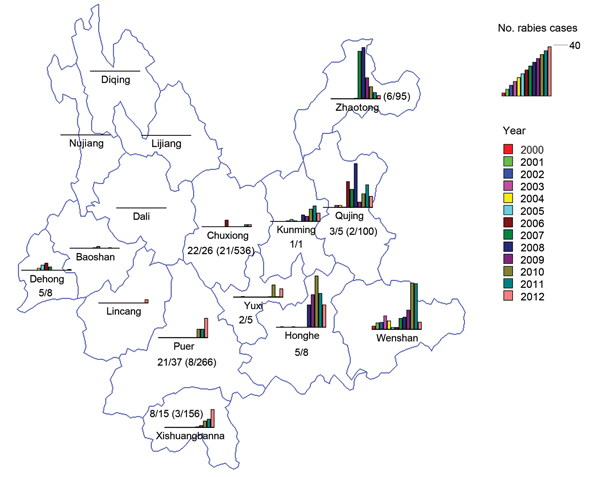Volume 20, Number 9—September 2014
Synopsis
Molecular Epidemiology of Reemergent Rabies in Yunnan Province, Southwestern China
Figure 3

Figure 3. Distribution of rabies cases in 16 prefectures in Yunnan Province, China, 2000–2012, and data analysis of human and animal specimens. Except for Dali, Lijiang, Nujiang, and Diqing Prefectures, 12 prefectures had reported human cases. The color key is a scale in which each color bar indicates the year and its length indicates the number of human cases in that year. The longest bar indicates 40 human cases. Values indicate number of rabies-positive samples/number of samples submitted for testing from sick dogs, dogs with suspected rabies, and patients. Values in parentheses indicate number of rabies-positive samples/number of samples submitted for testing from apparently healthy dogs in areas to which rabies is epidemic. During 2008–2012, a total of 1,267 specimens from 9 prefectures were submitted for testing, including 95 brains of apparently healthy dogs from Zhaotong where rabies is endemic (6/95); five brains of sick dogs (3/5) and 100 brains of apparently healthy dogs (2/100) from the rabies-endemic area of Qujing; 1 human brain (positive) and 7 saliva samples of patients with rabies (4/7) from Honghe; 5 saliva samples (2/5) from Yuxi; 1 brain of a sick dog (positive) from Kunming; 26 brains of sick dogs or dogs with suspected rabies (22/26) and 536 brains of apparently healthy dogs (21/536) from rabies-endemic areas in Chuxiong; 36 brains of sick dogs or dogs with suspected rabies (20/36), 1 brain of 1 sick cow, and 266 brains of apparently dogs (8/266) from rabies-endemic areas in Puer; 12 brains of sick dogs or dogs with suspected rabies (5/12), 165 brain samples of apparently healthy dogs (3/165), 1 human cerebrospinal fluid sample (positive), and 2 saliva samples (positive) of patients with rabies from the rabies-endemic area of Xishuangbanna; 7 brains of sick dogs or dogs with suspected rabies (4/7) and 1 human brain sample (positive) from Dehong; and 1 human brain sample (positive) from Pan County in Guizhou Province, a county bordering Qujing Prefecture in Yunnan Province. Samples were not obtained from Wenshan, Lincang, Dali, Baoshan, Lijiang, Nujiang, and Diqing Prefectures.
1These authors contributed equally to this article.